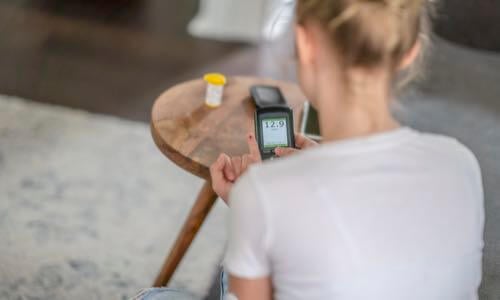The Connection Between Autoimmunity & T1D
In this section, Jodi Lavin-Tompkins asks Lucia Novak questions about how
she puts Type 1 diabetes (T1D) screening into practice and how Diabetes Care and Education Specialists (DCESs) and other health care professionals (HCPs) can advocate and educate people with diabetes about the
connection between autoimmunity and T1D.
Making Recommendations Around T1D Screening in Your Practice
Jodi Lavin-Tompkins: What is the traditional thinking about
T1D and how it needs to change to better address screening?
Lucia Novak: Type 1 diabetes is typically associated with
children and adolescents. This is when we see the initial peak incidence of T1D.
It is the most common chronic disease of childhood. But we see another increase
later in life, in individuals in their 40s through 60s. More than 50% of all
new cases diagnosed each year are adults. However, because T1D is usually not on our radar in people over age 30,
somewhere between 5% to 15% of adults with T1D are misclassified as having Type
2 diabetes (T2D).
In addition, we have seen a global rise in autoimmune disorders, in general,
by about 3% to 4% across the globe, and that includes T1D. As mentioned in section 1 of this series, many
autoimmune disorders are associated with a higher risk of developing T1D.
If you are a DCES or
another HCP for adults, you may ask, "Some of the individuals I
see may be at greater risk, but I cannot screen everybody — how do I
figure this out?"
The goal of this section is to help practitioners identify individuals with
whom they may need to go that extra step and screen for T1D — and/or recommend
their family members to be screened for T1D.
Jodi Lavin-Tompkins: What do DCESs and other HCPs need to know about T1D and its connection to
other autoimmune disorders?
Lucia Novak: Many autoimmune disorders — including T1D — share the same risk-associated HLA haplotypes, often resulting in comorbidity. Autoimmune disorders tend to coexist in one person and cluster in families.
If a person has one autoimmune disorder, they are likely to have at least one other; and if there is a family history, the individual is also at greater risk. Therefore, it is crucial to ask individuals about their personal and family medical history, including any autoimmune conditions — not just T1D.
Not screening for other autoimmune conditions in these cases is very similar to not checking cholesterol in someone who is known to have a family history of heart disease.
Jodi Lavin-Tompkins: What are the most common autoimmune disorders you see?
Lucia Novak: T1D is a common autoimmune disorder, but not the most common. The more common autoimmune conditions that are seen where I practice are thyroid conditions: Hashimoto's thyroiditis (autoimmune hypothyroidism), and Graves' disease (autoimmune hyperthyroidism).
Other related autoimmune diseases are described in section 1 and include celiac, intrinsic factor vitamin B12 deficiency (pernicious anemia), vitiligo, rheumatoid arthritis, autoimmune atrophic gastritis, and Addison’s disease, to name a few. Autoimmune disorders in general affect females more often than males at a rate of 2:1, and 80% of those with an autoimmune disorder are female. The sex-biased association is unknown, but research is being done to better understand it. While T1D specifically is not associated with gender, people who tend to have more than one autoimmune disorder (i.e., Hashimoto’s thyroiditis and T1D) are more often women between ages 40 to 60 years.
Jodi Lavin-Tompkins: Why is it important to know about these other autoimmune disorders when it comes to T1D screening and diagnosis?
Lucia Novak: As I mentioned earlier, T1D is being underdiagnosed, or in many cases, it is being misdiagnosed as T2D, especially in adults where 5% of 15% are being misclassified as having T2D. According to the ADA Standards of Care in Diabetes, soon after the diagnosis of T1D, individuals need to be screened for autoimmune thyroid disorders because there is such a high association between T1D and autoimmune thyroid disease. While the reverse is not as clear, we need to keep in mind the connection between autoimmune diseases.
Overall, practitioners need to trust their gut when the pieces do not seem to fit.
Examples of Connecting T1D to Autoimmunity in Practice
Jodi Lavin-Tompkins: Can you give us a couple of examples?
Lucia Novak: As you know, every
adult aged 35 years and older needs to be screened for diabetes, regardless of
risk factors. The type of diabetes we
are most often looking for is T2D — especially in the adult population. However, T2D is a disease of insulin
resistance and there are clinical manifestations and/or other diseases that are
associated with this classification (acanthosis nigricans, hypertension,
elevated triglycerides, low HDL, history of PCOS, fatty liver). Therefore, when you are screening for
diabetes and the values are abnormal but the person 1) has another known
autoimmune disorder or family history (such as Hashimoto’s thyroiditis or vitiligo),
and/or 2) does not have any signs, symptoms, or other disorders related to
insulin resistance, we need to determine if this person has autoimmune T1D.
Therefore, when I am repeating the A1C or glucose, I will add a T1D
autoimmune profile which includes the GAD65, IA-2, IAA, and ZnT8 autoantibodies. The one most likely to be positive in an
adult will be the GAD65 autoantibodies as it is the most sensitive and specific
biomarker associated with latent autoimmune diabetes of adulthood (LADA).
Jodi Lavin-Tompkins: What about individuals who have been
living with an incorrect diagnosis; what would that look like?
Lucia Novak: If you have a suspicion that something is not
right, follow up with that. It could be someone diagnosed with T2D years ago
and they are saying that they have had it for 30 years and their glucose has
never been well managed. Their A1C has never been less than 8, let alone less
than 7. So, I am looking at their labs, and the picture does not add up. For
example, they might be on a very low dose of lisinopril 2.5 mg. Yet they inform
you that they do not have high blood pressure but were told they need it to “protect
their kidneys.” Perhaps they are not on a statin or a very low dose of one and
they are without elevated TG and have normal HDL and TG and their LDL is under
100. It has been my experience that someone with 30 years of T2D needs a
high-intensity dose of a statin to achieve an LDL of < 70 and they typically
have low HDL with elevated TG. As you can see, the clinical picture does not add
up to this person having T2D.
Additionally, it is up to us to make sure their life story has no
missing pieces. For instance, they may be aware that their mother, sister, or
aunt have “thyroid problems” but do not know if it is an autoimmune disorder.
This would become a homework assignment for that person — to try to clarify that
family history — it is so important!
Jodi Lavin-Tompkins: Are some individuals being
misdiagnosed with T2D in part due to assumptions made because of factors like
weight and ethnicity?
Lucia Novak: Yes — traditionally, individuals of color are considered
at high risk for developing T2D compared to their White counterparts.
Therefore, if an adult is Black, Hispanic, or Asian and/or has overweight or
obesity, it is often assumed they have T2D.
Practitioners need to dig a little deeper into that personal and family medical history for the pieces of that autoimmune puzzle. What should drive determining who to screen is listening to the person and getting their full personal and family history. They are the experts in who they are and what they and their families have experienced. We are the experts in putting those pieces of information together to determine the risk/potential for diseases/disorders. We are instrumental in connecting the “diagnostic dots,” but we cannot do it without their input.
The Value of Screening for Family Members
Jodi Lavin-Tompkins: How do you recommend individuals with
T1D talk to their families about screening?
Lucia Novak: When individuals are seen in the clinic and
have T1D, they often will say they have no known family history of T1D. But
when you start asking about thyroid disorders, they will commonly say something
like, "Yeah, my mom has this." Then you discover there are other
endocrine or glandular issues going on. We must pause as DCESs and other HCPs and say,
"OK, this patient does not match someone showing evidence of insulin
resistance, impaired glucose tolerance, or impaired fasting glucose, and they
have all of this other ‘stuff’ going on."
I strongly advise and encourage the individuals I see with T1D to discuss
screening with family members, certainly first-degree relatives like parents,
siblings, and their children.
It also works the other way — someone with T1D needs to be screened for
other autoimmune disorders upon or shortly after diagnosis. I encourage their
family members to be screened for an autoimmune etiology if they have an
unclear diagnosis (i.e., hypothyroidism but not known if it is autoimmune; or a
history of stomach issues/food intolerances) with no real idea of the cause.
When it comes to autoimmunity disorders, it takes a village to figure it out — and that village includes the health care team, the patient, and their
family. Once one autoimmune disorder has
been diagnosed, it should remain high on the list of differential diagnoses for
other complaints, illnesses, and disorders.
Jodi Lavin-Tompkins: How do you convince individuals and
family members of the value of screening for T1D and/or autoimmune disorders,
beyond potentially getting bad news?
Lucia Novak: If they ask why they would want to find out if
they have got this, you can tell them, "It's really important that you
identify whether or not anyone else in your family has this so we can closely
monitor and reduce the risk or delay an acute, life-threatening hyperglycemic
event. Another reason would be to ensure the correct diagnosis has been made
between T1D and T2D as these two diseases are managed very differently."
The conversation might sound like, “Look, you (or a family member) have one
autoimmune disorder and the chances of having another are high compared to
someone without this type of disorder. Knowing if you are at risk for T1D will
allow you to prepare and enable you to live your best life."
Screening Coverage & Coding
Jodi Lavin-Tompkins: What do What do patients, DCESs, and other HCPs need to know
about the cost of screenings?
Lucia Novak: Tests such as screening the A1C or fasting
glucose, getting a B12 level, and the autoimmune panel are usually covered by
health insurance. I have been practicing for 30 years, and I have never had an
individual say their insurance did not cover their diabetes autoimmune screening.
I might get that for some other tests like a vitamin D level if I did not have
the appropriate diagnostic code, but I have not to this day had them come back
and say they had to pay out-of-pocket for autoimmune screening, but that may
not be everyone’s experience. If they
are informed that they will be charged, there is free testing for T1D
antibodies available to eligible individuals through certain centers or
research studies.
Jodi Lavin-Tompkins: How should practitioners code these
tests in their EHR?
Lucia Novak: Use the ICD code for screening; it is going to
be a Z code. "Screening for other suspected endocrine disorders" is
one of the ICD 10 codes that I use. Then I put in my rationale, such as:
"A history of autoimmunity/need to rule out." Then I list what I am
ruling out.
Diagnosing T1D
Jodi Lavin-Tompkins: If someone comes back with one
positive antibody for T1D, does that mean they have T1D?
Lucia Novak: Well — we are still speaking about screening — which is done in asymptomatic
people. Therefore, keeping this in mind,
when screening for T1D in someone who is asymptomatic (euglycemic) — we are
looking for the presence of autoantibodies to determine risk for T1D. The presence of at least 2 autoantibodies is
associated with an almost 70% conversion to overt T1D. They will progress more
rapidly to stage 2 and then to stage 3. Those screened and found to have only 1
positive autoantibody have less than 15% conversion to T1D — and may revert to
negative and not progress at all. However, these individuals will need to be monitored.
If there is a family history of T1D, and initial screening detects no
autoantibodies it is recommended that individuals be periodically rescreened for
autoantibodies — perhaps every 1 to 3
years — depending on other risk factors (such as the number of family members
with T1D, prevalence of other autoimmune disorders, history of hyperglycemia
(i.e., when exposed to glucocorticoid, illness).
If one autoantibody is detected, rescreen annually to observe for others to
become positive — and begin to monitor glucose to determine the transition to
early metabolic decompensation (stage 2).
If two or more autoantibodies are detected, you are no longer screening for
risk of T1D — this is diagnostic for stage 1 T1D. Additional and
future testing would focus on monitoring for early metabolic decompensation (progression
from stage 1 to stage 2) and once in stage 2, to reduce the risk or delay DKA
when progressing to stage 3.
Once someone has progressed to stage 2, the ADA recommends monitoring for
clinical T1D (stage 3) by performing A1C
testing every 6 months and obtaining 75 g oral
glucose tolerance test (i.e., fasting and 2 h plasma glucose) every year. Some DCESs and other HCPs may be inclined to place patients
on CGM to closely monitor glucose patterns and initiate insulin as soon as
dysglycemia is recognized.
Key Takeaways
- Autoimmune disorders cluster in families.
- When an individual has one autoimmune disorder, have a higher degree of suspicion that other autoimmune disorders are present.
- All adults aged 35 years and older should be screened for diabetes. If results identify prediabetes, consider other comorbid conditions and question if a diagnosis of stage 2 T1D should be considered.


 Guidance on clinical assessment, adjustments, report interpretation and key education. Designed to be used during clinic visits.
Guidance on clinical assessment, adjustments, report interpretation and key education. Designed to be used during clinic visits.-(3).jpg?sfvrsn=16486d59_5)





























